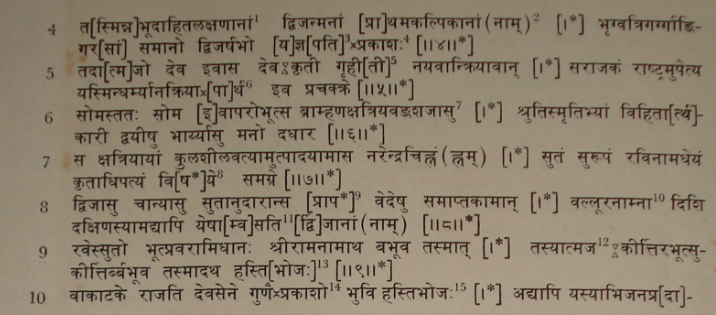|
INSCRIPTIONS OF THE MINISTERS AND FEUDATORIES OF THE
VATSAGULMA BRANCH

_______________________
1Bhagvanlal and Bühler read दाह्तलक्षणना, but traces still remain of a curve on ह
Cf. ककुत्स्थ
इत्याहितलक्षणेभूत् in Raghnvaṁśa, VI, 71.
2 Bhagvanlal read प्राथमकल्पकाना, but Bühler gave the correct reading प्राथमकल्पिकानां
3 Bhagvanlal could not restore the name of the progenitor of this family. He read यज्ञः प्रकाश;, and
thought यज्ञप्रकाश was his proper name. प्रकाश is, however, used by the poet elsewhere also in the sense of
‘well-known’, See lines 3 and 10, below. Bühler suggested यज्ञधरः and यज्ञपति: as possible readings, and
decided in favour of the latter. The name is fairly clear in the fresh estampages. The curve on the last
letter is still seen. So यज्ञपति: is undoubtedly the correct name. There are traces of the upadhmāniya on pra.
4 Metre of verses 4-12 : Upajāti. 5 Bhagvanlal read गृहस्थो, but as Bühler pointed out, the i mark of गृही is quite plain. The next akshara also which was not read by Bühler has a similar ī-mark. The intended reading seems to be गृहीती. Cf. गृहीती षट्स्वङ्गेषु in the Daśakumāracharita (Bom. Sanskrit Series, 1919), p. 100. 6 Bhagvanlal read पार्त्थ and Bühler नाथ. The first akshara of the word is fairly clear with the
sign of Pārtha is almost certain. The second akshara is still quite clear. It is र्थे and not त्थ,
nor थ 7 Bhagvanlal and Bühler read वंशजासु. but the superscript guttural nasal is quite clear-Read वंशजासु, 8 Both Bhagvanlal and Bühler read this word as मलये. The first akshara appears more like vi than ma, the curve on it being still quite clear. The second akshara is now very much damaged. It
was probably so in the days of Bhagvanlal and Bühler also. The facsimile published in A.S.W.I. (PI. LX) shows it to be la, but its accuracy is doubtful; for in this epigraph the letter l has invariably
its right limb sharply turned to the left in the form of a curve, but this l in Bhagvanlal’s copy has a
straight vertical stroke on the right Cf. the forms of l in आहितलक्षणानां and प्राथमकल्पिकानां both in line 4,
कुलशील in line 7, बल्लूर in line 8, धबलां in line 14, and फलमखिल- in line 17. In all these cases l has the same
form, with its right limb bent over like a curve. The correct reading therefore appears to be विषये.
9 Bhagvanlal read here doubtfully सोम, and Bühler, स[म्म]स्त. Neither of these reading gives a verb
which is necessary in this verse. The aksharas here are damaged. Restore प्राप.
10 Both Bhagvanlal and Bühler read वल्लुरनाम्ना, but Bühler proposed to emend it as वल्लुरनाम्नां. The
proposed emendation is unnecessary. The Brāhmaṇas were known as Vallūras (v. 3, above), because
they were residing at Vallūra as stated here. Cf. उदुम्वरनामान: which occurs in the description of the
ancestors of Bhavabhūti. Mālatīmadhava, Act I.
11 Read येषां वसति-.
12 Bhagvanlal and Bühler read तदात्मज-, but the subscript y of the akshara following to shows that it is
probably sya.
13 Bhagvanlal read ह[स्तिभोज:], and Bühler, [हस्तिभोज:] The first two aksharas of this name are quite
certain, but the last two are now damaged.
14 Both Bhagvanlal and Bühler read this word as गुणैषिकोशो which does not yield good sense. What
they took as the i-mark of shi is really the sign for the upadhmāṁya above pra. Read गुणैप्रकाशो.
The
poet has used प्रकाश elsewhere also in this inscription; see above, lines 3 and 4.
15 The aksharas भुवि, which were fairly clear in the days of Bhagvanlal and Bühler, are now much
damaged. The first akshara ह of the name हस्तिभोज is partially damaged but the following aksharas can be read from the traces still remaining.
|